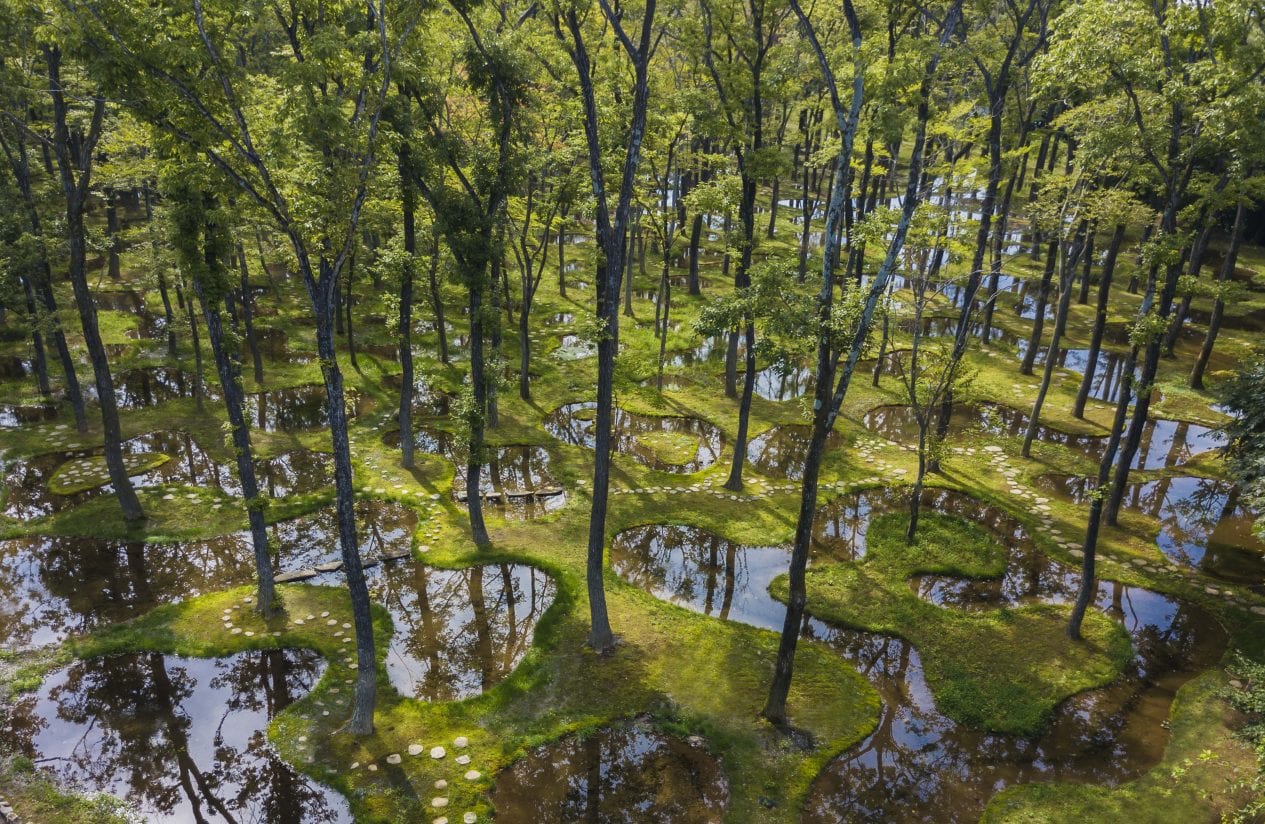A New Nature Created by Junya Ishigami
Art Biotop Water Garden, an artificial landscape by Junya Ishigami near the Nasu Mountains in Japan, straddles architecture, landscape, art, and environmentalism.
At the foot of Mount Nasu in Tochigi, a prefecture north of Tokyo lies a garden of serene beauty. The new Botanical Farm Garden Art Biotop is an outdoor extension of the existing Art Biotop Nasu, a resort that offers courses in pottery, glass making, and other artistic activities. Earlier, the site was a paddy field; earlier still, a forest overgrown with moss. Traces of the site’s history remain, such as a sluice gate to draw water. 

The site of the new hotel or the resort was a forest, where many trees had to be cut down due to construction. Because the total area of the forest site and that of the meadow site were nearly the same, Junya Ishigami proposed to relocate the entire forest to the adjacent meadow. Through this act, the meadow site is transformed not only by moving the forest but also by superimposing all the layers from past environments in the site’s history: the landscape of the paddy field and the landscape of the mossy forest are overlapped as one. Trees from the adjacent forest are rearranged on the site, and water is drawn in from the existing sluice gate to fill countless ponds, all connected to the existing irrigation system with water flowing continuously at different rates. The ponds and trees spread across the entire site at a close density never found within nature, with moss laid out beautifully to fill the spaces in between. With this new mossy forest of innumerable trees and limitless ponds, a new nature never before seen appears on the site.
A new international prize Obel Award of €100,000 (£86,000), one of the world’s richest architecture prizes, given by the Henrik Frode Obel Foundation to a project completed in the last five years that offers “seminal solutions to urgent problems” was awarded to this project by Junya Ishigami. 

Landscapes that were originally here, but never met, mix and mingle with each other. Trees from the adjacent forest are rearranged on the site and water is drawn in from the existing sluice gate to fill countless ponds, which are all connected to the existing irrigation system with water flowing continuously at different rates. The ponds and trees are spread across the entire site at a density that is never found in nature. Moss is laid out beautifully to fill the spaces in between.
“Planning landscapes is similar to planning architecture. Extending the scale of architecture and increasing the accuracy and specificity of the landscape are realized simultaneously. By planning specific shapes of trees and ponds, the vague scenery of the forest is given a framework and considered as a space with as much detail as possible. By moving trees to the adjacent site and rearranging them, the pieces of the puzzle are intentionally shifted. The autonomy of each tree is born. Luminous spaces appear between 318 unique tree shapes, at the same time 160 ponds are designed among these trees,” says Junya Ishigami, “Trees that are moved and rearranged are all deciduous trees such as beech, Quercus, etc. These tree species cannot coexist with water in close proximity to the existing natural environment. By applying to waterproof in the ponds, this coexistence and a new relationship that never existed are created. “
According to the jury, “With its deliberate composition of natural elements, the man-made landscape Art Biotop Water Garden resets the boundaries between architecture, landscape architecture, art, and environmentalism.”
The garden is at once a highly artificial landscape, carefully modeled and dependent on technological artifacts, and an undeniably natural and living organism that grows and changes by its own inherent dynamics. In this way, the garden intermingles different time-spaces: a presence of former, existing and future layers of landscapes. But although it is a large-scale and rather invasive project involving, as it does, the relocation of an entire forest tree by tree. Junya makes it evident what great respect and care for the environment mean.
Junya’s approach relies in large part on emotions and sensations and is based on the context and the qualities of the landscape. The result is a landscape full of beauty and atmosphere – a highly poetic space that strongly influences the emotions of the visitor.
Junya leaves visitors with questions as to how human beings can intervene in the natural environment? He asks us how the new nature created will change our living environment. By planning nature in a detailed way, natural environment and human environment mingle, intertwine and merge more closely, he says. 

Junya is part of the young generation of Japanese architects that emerged in the 2000’s. Appearing to break away from architecture’s rules and constraints, his work was quickly recognized for its originality and awarded numerous prizes. He completed the Serpentine Pavilion in London this year.
Botanical Garden Art Biotop / Water Garden
Program: Garden
Total site area: 16,670m2
Project architects: Junya Ishigami, Eiko Tomura, Taeko Abe, Lucie Loosen, Gaku Inoue, Akira Uchimura, Masayuki Asami
Contractor: Shizuoka Green Service Co.
Period: 2013 – 2018
Pictures courtesy The architects







